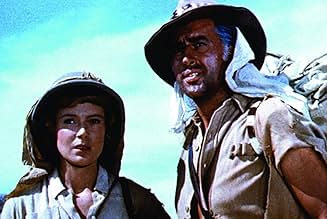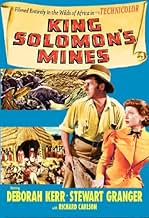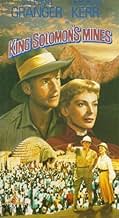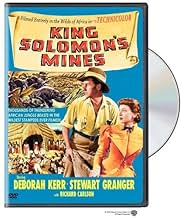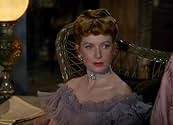L'avventuriero Allan Quartermain guida una spedizione in territori africani inesplorati nel tentativo di individuare un esploratore scomparso durante la sua ricerca delle leggendarie miniere... Leggi tuttoL'avventuriero Allan Quartermain guida una spedizione in territori africani inesplorati nel tentativo di individuare un esploratore scomparso durante la sua ricerca delle leggendarie miniere di diamanti del re Salomone.L'avventuriero Allan Quartermain guida una spedizione in territori africani inesplorati nel tentativo di individuare un esploratore scomparso durante la sua ricerca delle leggendarie miniere di diamanti del re Salomone.
- Regia
- Sceneggiatura
- Star
- Vincitore di 2 Oscar
- 4 vittorie e 2 candidature totali
- Chief Gagool
- (as Sekaryongo of the Watussi Tribe)
- King Twala
- (as Baziga of the Watussi Tribe)
- Chief Bilu
- (non citato nei titoli originali)
- Austin - Safari Client
- (non citato nei titoli originali)
- Black Circle
- (non citato nei titoli originali)
- Kafa - Umbopa's Old Uncle
- (non citato nei titoli originali)
- Traum - Safari Client
- (non citato nei titoli originali)
Recensioni in evidenza
This film boasts two directors, Compton Bennett and Andrew Marton! The film is set in Africa. At the beginning of the film we watch Allan Quattermain who is guiding a group in a safari and a herd of elephants come near and one is killed. We watch in horror as the others rally around the dead animal in an almost human display of emotions.
Quartermain is contacted by Elizabeth Curtis, a woman that wants to locate her husband who has come to the region in search of the legendary diamond mines of King Solomon's. He is reluctant, but since she meets his price, the excursion is organized. What Mrs. Curtis, or Quartermain, or even the third member of the mission, Jack Goode, don't realize at the outset of the trip is what they are in for! The trek turns into one of the most extraordinary adventures ever filmed. Some of the scenes involving wild animals are incredible. In fact, some of the things this party has to deal with are amazing. Especially impressive is the stampede sequence when one watch in horror how all these wild animals are running amok.
Stewart Granger is Quartermain, the jaded Englishman living in that remote spot. He loves it there and would never go back to his country. Mr. Granger was perfect for this type of film in which he clearly excelled. Deborah Kerr plays the English lady in search for her husband. She sticks out like a sore thumb, but in the end, she proves to have a strength we didn't give her credit for. Ms. Kerr was always a good in whatever she undertook. Richard Carlson makes a good contribution to the film.
The different natives shown in their own habitat add veracity to the movie. The tall Watusi tribe is the most exotic one we have seen in any films of this type.
Kerr is actually seeking the best of guides so she can hunt for her husband, so she takes along her good friend RICHARD CARLSON. Naturally, a romantic attachment to Granger gradually develops once Kerr starts to melt under the African sun.
All of the scenes involving actual native tribes are beautifully staged and handled with a sense of excitement and adventure, as are the scenes of wild animals. But it's basically a showcase for MGM's new property, Miss Kerr, and their new leading man, Mr. Granger.
It kept fans happy when it opened at New York's Radio City Music Hall in the summer of '50, but today it's largely forgotten among the many gems that came out that year. It did win a couple of Oscars, one for the beautiful color cinematography.
Secondly, the MGM crew of about 30 people and 7 cargo trucks spent months in 1949 filming this on the Dark Continent itself, at locations hundreds of miles from civilization in eastern Africa instead of the usual Hollywood lots. They enlisted the inhabitants of remote villages as actors, asked them to perform communal dances, and took many close-up shots of their faces, hair, headgear, jewelry and body paint. This amounts to some of the most magnificent - and rare - color and sound footage of "old" untouched African culture I've seen.
Not long after this, during the 1950's-1960's these villages gradually became part of the modern world, and by the 1980's, remote tribesmen were filmed as they hunted with spears - wearing "Michael Jackson" t- shirts.
The movie is generally pretty good, but the Africans steal the show.
Of course, that was before TV brought the world into living rooms everywhere. The movie may have lost that long ago novelty, but it's still a good story set in what was then colonial Africa, with a first-rate cast, including the exotic Umbopa, the prince in exile. Then there's that thundering stampede whose mighty numbers still impress.
Like many reviewers, I cringe now at the elephant kill. I'm sure I didn't at the time, but then this ecological type change reflects a newer awareness, and one I think for the better. Actually, Quartermain (Stewart) is also bothered by big game kills, one reason he's ready to give up his hunting safaris.
Happily, Stewart's persuasive as the experienced white man, while Kerr does nicely as the British gentlewoman able to adapt her well-bred ways. (However, MGM, ever the glamour studio, refuses to de-glamorize her no matter how rough the going). I do feel a little sorry for tag-along John (Carlson) who, nevertheless, hangs in there. On the other hand, I'm still curious about the van Brun (Haas) role. Was that episode in the book or was it added to diversify and perhaps pad the storyline.
No, those old promotionals about Africa in Color wouldn't work now. But the movie's still an eyeful with a good adventure yarn and a fine cast, and those are film features that do endure.
Let me mention just one striking 'detail': what's going on on screen is SO fascinating that no music has been added to the various sounds emanating from the country or from the music instruments of the African people themselves. This was a daring move, especially at the time, but it enriched the movie enormously.
I will end this quick review with a piece of advice: Your mind should be as free as possible from everyday's life various troubles if you want to enjoy this movie. Pick up a night when you are already rather relaxed, and immerse yourself gently into the atmosphere created by the filmmakers. You won't regret it.
Lo sapevi?
- QuizThe elephant stampede sequence in the film was reshot in Hollywood using a trained elephant, as the footage of the actual stampede in Africa was lost when the cast and crew of the film fled from the deadly rush of the animals.
- BlooperThe elephant that charges the hunter and guide is an African elephant. The one that picks the guide up and tosses him over its shoulder is a trained Indian elephant. African elephants are too aggressive to be trained for such stunts.
- Citazioni
Allan Quatermain: Mrs. Curtis, the average life of a man in my profession is approximately eight years. Now, I've been at it for fifteen, so you see, I've been living on borrowed time. My wife died here six years ago. Sooner or later, an animal, or an unfriendly native, or a tropical disease will get me. I have a son in England. There'll be very little money for him if anything should happen to me in the ORDINARY course of events, but the money you're offering would provide very nicely for the boy until he's old enough to take care of himself.
- ConnessioniEdited into Vatussi (1959)
I più visti
Dettagli
- Data di uscita
- Paese di origine
- Lingua
- Celebre anche come
- King Solomon's Mines
- Luoghi delle riprese
- Azienda produttrice
- Vedi altri crediti dell’azienda su IMDbPro
Botteghino
- Budget
- 2.258.000 USD (previsto)
- Lordo in tutto il mondo
- 951 USD
- Tempo di esecuzione1 ora 43 minuti
- Colore
- Proporzioni
- 1.37 : 1
Contribuisci a questa pagina




